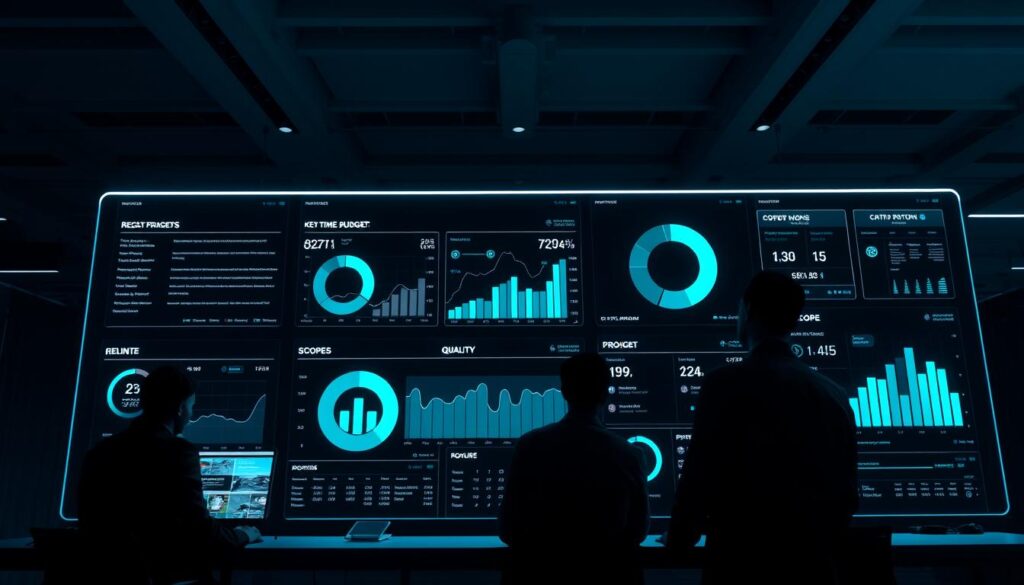A successful project manager is crucial for the delivery of projects on time, within budget, and to the required quality standards. The role of a project manager has become a distinct profession, with many finding success in it.
Effective project managers oversee the planning, execution, and closure of projects, ensuring that all stakeholders are informed and aligned with the project goals. Their key duties include leading cross-functional teams, managing resources, and mitigating risks.
Understanding the project manager roles and responsibilities is essential for delivering successful projects and advancing in this career path.
Key Takeaways
- Project managers play a vital role in delivering projects on time and within budget.
- Their key duties include planning, execution, and project closure.
- Effective project managers lead cross-functional teams and manage resources.
- Understanding project manager roles is crucial for career advancement.
- Project managers must mitigate risks and ensure stakeholder alignment.
What Is a Project Manager?
Project managers play a crucial role in ensuring projects are executed efficiently and effectively. They are responsible for overseeing projects from initiation to close, ensuring the work gets done efficiently and satisfactorily, as noted by experts in the field.
Definition and Overview
A project manager is a professional who plans, organizes, and controls resources to achieve specific goals. They are the linchpin of any project, ensuring it is completed on time, within budget, and to the required quality standards. As project management experts, they possess a unique blend of skills, including leadership, communication, and problem-solving.
Importance in Various Industries
Project managers are essential in various industries, including construction, IT, finance, and healthcare. Their role is critical in ensuring projects are executed smoothly, and their skills are highly valued across different sectors. According to industry experts, “A good project manager can make the difference between a project’s success and failure.” This highlights the importance of effective project management in achieving project goals.
The skills and qualifications of a project manager are diverse, ranging from technical knowledge to soft skills like team management and stakeholder engagement. Their ability to adapt to changing project requirements and manage risks is crucial to project success.
“Project managers are the driving force behind successful projects, leveraging their skills and expertise to deliver results.”
Primary Roles of a Project Manager

The primary roles of a project manager encompass leadership, team management, and stakeholder communication, all crucial for achieving project objectives. A project manager is accountable for every aspect of the project, including leading a team capable of meeting or exceeding client expectations.
Leadership and Team Management
Effective leadership is critical in project management. It involves guiding the team towards the project’s objectives, making informed decisions, and resolving conflicts. A project manager must possess strong leadership skills to motivate team members and drive the project forward. According to insights on leadership in project management, a leader’s ability to inspire and direct the team is paramount.
Team management involves organizing and coordinating team members’ efforts to achieve project goals. This includes assigning tasks, monitoring progress, and providing feedback. A well-managed team is more likely to deliver a successful project.
| Leadership Skill | Description | Impact on Project |
|---|---|---|
| Decision Making | The ability to make informed, timely decisions. | Ensures project progress and resolves issues. |
| Conflict Resolution | The skill to resolve disputes and disagreements. | Maintains a positive team dynamic. |
| Motivation | The ability to motivate team members. | Enhances team productivity and morale. |
Communication and Stakeholder Engagement
Effective communication is vital in project management, ensuring that all stakeholders are informed and aligned with the project’s objectives. Project managers must communicate clearly with team members, clients, and other stakeholders to avoid misunderstandings and ensure project success.
Stakeholder engagement involves identifying, analyzing, and responding to the needs of stakeholders. This includes understanding stakeholder expectations and managing their engagement throughout the project lifecycle.
By focusing on leadership, team management, and stakeholder communication, project managers can ensure the successful delivery of projects. These roles are interdependent and crucial for achieving project objectives.
Project Planning Responsibilities
Project managers play a crucial role in planning projects, from defining the project scope to allocating resources. Effective project planning is essential for the successful execution of any project, as it lays the groundwork for all subsequent activities.
According to industry experts, a project manager’s responsibilities include collaborating with internal stakeholders and external clients to define the project’s objectives and create a roadmap for achieving them.
Defining Project Scope
Defining the project scope is a critical task that involves identifying the project’s objectives, deliverables, and boundaries. It requires a thorough understanding of the project’s requirements and stakeholders’ expectations. As noted by industry professionals, “A well-defined project scope is essential for preventing scope creep and ensuring that all stakeholders are aligned with the project’s goals.”
“A project scope statement is a crucial document that outlines what is included and excluded from the project, helping to manage stakeholder expectations and guide the project team’s efforts.”
Resource Allocation
Resource allocation is another vital aspect of project planning, involving the assignment of necessary resources, such as personnel, equipment, and materials, to various tasks and activities. Effective resource allocation ensures that the project is completed on time, within budget, and to the required quality standards.
A project manager must carefully plan and manage resources to maximize efficiency and productivity. This involves identifying the resources required for each task, allocating them accordingly, and monitoring their utilization throughout the project lifecycle.
By focusing on these key areas, project managers can ensure that their projects are well-planned, executed efficiently, and ultimately successful.
Budget Management

One of the primary duties of a project manager is to oversee the budget of the project. Effective budget management is essential to ensure that the project is completed within the allocated financial resources.
Creating Project Budgets
Creating a project budget involves estimating the total cost of the project, including labor, materials, and overheads. It requires a thorough understanding of the project scope and the resources required to complete it.
Key steps in creating a project budget:
- Identifying all cost elements
- Estimating costs for each element
- Aggregating the costs to form the total budget
Monitoring and Controlling Costs
Once the budget is established, the project manager must monitor and control costs throughout the project lifecycle. This involves tracking actual expenditures against the budget and taking corrective action when necessary.
Effective cost control measures include:
- Regularly reviewing financial reports
- Identifying and addressing cost variances
- Implementing cost-saving initiatives
To illustrate the importance of budget management, consider the following example:
| Project Phase | Budgeted Cost | Actual Cost | Variance |
|---|---|---|---|
| Planning | $10,000 | $9,500 | -$500 |
| Execution | $50,000 | $55,000 | $5,000 |
| Monitoring & Control | $5,000 | $4,500 | -$500 |
By effectively managing the budget, project managers can ensure that projects are delivered on time, within budget, and to the required quality standards.
Risk Management Strategies
Risk management strategies are essential for navigating project uncertainties. Project managers need to anticipate potential risks and develop mitigation plans to minimize their impact.
Identifying Potential Risks
Identifying potential risks involves analyzing the project scope, stakeholders, and external factors that could affect the project’s success. This process includes:
- Reviewing historical data from similar projects
- Conducting stakeholder analysis
- Assessing external factors such as market conditions and regulatory changes
Risk identification techniques such as SWOT analysis, brainstorming sessions, and expert judgment are commonly used. These techniques help in creating a comprehensive risk register that lists potential risks and their characteristics.
Developing Mitigation Plans
Once potential risks are identified, the next step is to develop mitigation plans. This involves:
- Assessing the likelihood and impact of each identified risk
- Prioritizing risks based on their risk score
- Developing response strategies for high-priority risks
Mitigation plans can include risk avoidance, risk transfer, risk mitigation, and risk acceptance. The chosen strategy depends on the nature of the risk and the project’s risk tolerance.
| Risk Mitigation Strategy | Description | Example |
|---|---|---|
| Risk Avoidance | Eliminating the risk by removing its cause | Cancelling a project task that is too risky |
| Risk Transfer | Shifting the risk to a third party | Outsourcing a task to a specialist vendor |
| Risk Mitigation | Reducing the risk’s impact or likelihood | Implementing safety measures to reduce accidents |
| Risk Acceptance | Accepting the risk and its potential impact | Deciding to proceed with a task despite known risks |
Effective risk management is a continuous process that requires ongoing monitoring and review. By identifying potential risks and developing mitigation plans, project managers can significantly enhance the likelihood of project success.
Monitoring Project Progress

Monitoring project progress is a vital responsibility of a project manager. It involves tracking the project’s advancement towards its objectives, identifying any deviations from the plan, and taking corrective actions to ensure the project stays on track.
Key Performance Indicators (KPIs)
KPIs are quantifiable measures used to evaluate the success of a project. Project managers use KPIs to assess progress against project goals. Common KPIs include project schedule performance, budget variance, and resource utilization. For instance, a project manager might track the percentage of completed tasks or the number of milestones achieved within a specific timeframe.
By regularly reviewing these KPIs, project managers can identify areas that require improvement and adjust their strategies accordingly. This proactive approach helps in mitigating risks and ensuring that the project meets its intended objectives.
Status Reporting Techniques
Effective status reporting is crucial for keeping stakeholders informed about project progress. Techniques include regular status meetings, written reports, and dashboard updates. These methods provide transparency and help in managing stakeholder expectations. For more insights on project monitoring and control, visit Resource Guru or explore how civil engineering projects utilize these techniques on World Civil Society.
Regular status updates also facilitate timely decision-making and help project managers address any issues promptly. By maintaining open lines of communication, project managers can foster a collaborative environment that supports project success.
Quality Control in Projects
Quality control is an essential aspect of project management that ensures deliverables meet the required standards. Project managers are responsible for ensuring that the project meets the required quality standards, as noted in a recent study on quality control in project management.
Establishing Quality Standards
Establishing quality standards is the first step in ensuring that a project meets its quality objectives. This involves defining the quality metrics, identifying the quality assurance processes, and determining the quality control measures to be implemented throughout the project lifecycle. According to engineering project management objectives, setting clear quality standards is crucial for project success.
The process of establishing quality standards includes:
- Defining quality metrics and benchmarks
- Identifying quality assurance processes
- Determining quality control measures
- Establishing procedures for addressing quality issues
Ensuring Deliverable Quality
Ensuring deliverable quality involves monitoring and controlling the project’s progress against the established quality standards. This includes regular inspections, testing, and review of project deliverables to identify any defects or deviations from the quality plan.
| Quality Control Measure | Description | Frequency |
|---|---|---|
| Regular Inspections | Checking project deliverables against quality standards | Weekly |
| Testing and Review | Verifying that deliverables meet the quality metrics | Bi-Weekly |
| Defect Identification and Correction | Identifying and addressing defects or deviations | As needed |
By implementing these quality control measures, project managers can ensure that their projects are completed to the required quality standards, enhancing stakeholder satisfaction and project success.
Team Development and Support

The ability of a project manager to develop and support their team directly impacts the project’s overall success. Effective team development is crucial for enhancing collaboration, improving productivity, and achieving project goals.
Training and Onboarding New Team Members
A key responsibility of a project manager is to ensure that new team members are properly trained and onboarded. This involves providing comprehensive training programs that equip team members with the necessary skills and knowledge to perform their tasks effectively. A well-structured onboarding process helps in reducing the learning curve and enables new members to contribute to the project sooner.
Project managers should also focus on creating a supportive environment where team members feel encouraged to ask questions and seek help when needed. This can be achieved through regular check-ins and feedback sessions, which help in identifying any gaps in knowledge or skills and addressing them promptly.
Facilitating Team Collaboration
Facilitating team collaboration is another critical aspect of team development. Project managers can foster collaboration by promoting a culture of openness and transparency within the team. This includes encouraging cross-functional teamwork and using collaboration tools that facilitate communication and information sharing.
- Regular team meetings to discuss project progress and address any challenges.
- Using project management software to track tasks and collaborate on documents.
- Organizing team-building activities to enhance trust and camaraderie among team members.
By focusing on team development and support, project managers can significantly enhance their team’s performance and overall project success. It’s about creating an environment where team members can grow, collaborate effectively, and contribute their best to the project.
Tools Used by Project Managers
To manage projects efficiently, project managers use a range of specialized tools. These tools are crucial for planning, executing, and monitoring projects, ensuring they are completed on time and within budget.
Project Management Software
Project management software is a vital tool for project managers, enabling them to plan, organize, and control their projects. Popular project management software includes Asana, Trello, and Microsoft Project. These tools help in resource allocation, task assignment, and progress tracking. For more information on the tools used by project managers, you can visit this resource.
Communication Platforms
Effective communication is key to successful project management. Communication platforms like Slack and Microsoft Teams facilitate real-time communication among team members, stakeholders, and clients. These platforms support various communication methods, including instant messaging, video conferencing, and file sharing.
By leveraging these communication platforms, project managers can ensure that their teams are well-coordinated and informed throughout the project lifecycle.
The Role of the Project Manager in Agile

Agile project management has become a cornerstone for many organizations, and the project manager’s role is pivotal in this context. Agile methodologies have transformed the way projects are executed, emphasizing flexibility, collaboration, and rapid delivery.
Agile Methodology Overview
Agile is an iterative and adaptive approach to managing projects. It focuses on breaking down work into smaller, manageable chunks, and delivering them in short cycles. This methodology encourages continuous improvement and flexibility in response to change. According to APMG International, Agile project managers facilitate this process by ensuring that the team remains focused on delivering value to the customer.
The Agile manifesto, which underpins this methodology, values individuals and interactions, working software, customer collaboration, and responding to change. It is a significant shift from traditional project management practices, which often follow a linear and rigid plan.
Scrum and Kanban Frameworks
Two of the most popular frameworks used in Agile project management are Scrum and Kanban. Scrum is a framework that emphasizes teamwork, accountability, and iterative progress toward well-defined goals. It involves roles such as the Product Owner, Scrum Master, and Development Team, and ceremonies like Sprint Planning, Daily Scrum, Sprint Review, and Sprint Retrospective.
Kanban, on the other hand, is a visual system for managing work, emphasizing continuous flow and limiting work in progress. It does not prescribe specific roles or ceremonies but focuses on visualizing the workflow, limiting WIP, and enhancing flow.
| Framework | Key Components | Focus |
|---|---|---|
| Scrum | Roles (Product Owner, Scrum Master, Development Team), Ceremonies (Sprint Planning, Daily Scrum, etc.) | Teamwork, Accountability, Iterative Progress |
| Kanban | Visual Workflow, WIP Limits, Continuous Flow | Visual Management, Limiting WIP, Enhancing Flow |
Both Scrum and Kanban have their strengths and are chosen based on the project’s specific needs and the team’s preferences. As Agile project management continues to evolve, understanding these frameworks is crucial for project managers to effectively manage and deliver projects.
In conclusion, the role of the project manager in Agile is multifaceted, involving leadership, facilitation, and ensuring that the team has the resources and support needed to deliver projects successfully. By understanding Agile methodologies and frameworks like Scrum and Kanban, project managers can better navigate the complexities of modern project management.
Handling Changes and Adjustments
Project managers must adeptly handle changes to ensure project objectives are met. Handling changes and adjustments is a critical aspect of project management, as it directly impacts the project’s timeline, budget, and overall success.
Change Request Process
The change request process is a systematic approach to managing changes in a project. It involves:
- Identifying the need for change
- Documenting the change request
- Assessing the impact of the change
- Obtaining approval from relevant stakeholders
- Implementing the change
This process ensures that all changes are thoroughly assessed and approved before implementation, minimizing potential disruptions to the project.
Handling Scope Creep
Scope creep refers to the uncontrolled changes or continuous growth in a project’s scope, which can lead to delays, cost overruns, and reduced quality. To handle scope creep, project managers should:
- Clearly define the project scope at the outset to prevent misunderstandings.
- Monitor and control changes to the scope, ensuring that all stakeholders are informed and agree on any adjustments.
- Establish a robust change management process to handle requests for changes.
By being proactive and having a structured approach to managing changes, project managers can mitigate the risks associated with scope creep and ensure that the project stays on track.
Effective Communication Skills

Effective communication is the backbone of successful project management. Project managers need to have effective communication skills to manage projects successfully, ensuring that all stakeholders are informed and aligned with project goals.
According to recent studies, project managers with good communication skills can significantly improve project outcomes by reducing misunderstandings and enhancing team collaboration. For more insights on improving engineering management communication, visit this resource.
Importance of Clear Communication
Clear communication is vital in project management as it helps prevent errors, ensures that tasks are understood, and fosters a positive team environment. Clear and concise communication enables project managers to articulate project vision, goals, and expectations to team members and stakeholders.
Moreover, clear communication facilitates the exchange of ideas, feedback, and concerns among team members, promoting a collaborative work environment. It also helps in managing stakeholder expectations by keeping them informed about project progress and any changes.
Communication Techniques for Managers
Project managers can employ several communication techniques to enhance their effectiveness. These include:
- Active listening to understand team members’ concerns and ideas.
- Using clear and concise language in all communications.
- Adapting communication styles to suit different stakeholders.
- Encouraging open feedback and creating a safe environment for team members to express their views.
By mastering these communication techniques, project managers can improve team dynamics, reduce conflicts, and ensure that projects are executed smoothly.
Career Path and Advancement
Project managers can look forward to a diverse career path with numerous opportunities for advancement. To progress in their careers, they must acquire the necessary project manager qualifications and skills.
Skills and Qualifications
Key skills required for project managers include leadership, communication, and organization. Typically, project managers have around 7 years of experience, while senior project managers have around 11 years of experience. Directors of project management usually possess around 12 years of professional experience.
Opportunities for Growth
With experience, project managers can move into senior roles, such as senior project manager, with an average US base salary of $126,297. Further career advancement opportunities include director of project management, with an average US base salary of $154,674. Executive-level positions, such as Vice President of Operations and Chief Operating Officer, offer average US base salaries of $159,557 and $167,140, respectively.
The US Bureau of Labor Statistics projects about 1.2 million job openings in the project management field, indicating significant growth opportunities for project managers.
